

A Sushi Story
|
Without a doubt, sushi is the representative dish of Japanese food. A slice of raw fish draped over oval-shaped vinegared rice, also known as nigiri-zushi, would be what comes to most people’s minds. The way it is made is suggested by the name, with nigiri meaning “press in the hand” and zushi referring to “sushi”. However, this popular form of sushi was only created around 1830 in the Edo period, as the fast food of its time. In fact, the history of sushi stretches much further back.
The origins of sushi is said to be Southeast Asia, where rice farmers pickle salted fish in rice or other starchy food. You may still be able to find this today in Laos, Thailand and Cambodia. This method spread to China, and eventually came to Japan from China together with rice farming techniques. The sushi made back then would be most similar to today’s funa-zushi from Shiga prefecture, a regional variation that has the longest history of all Japanese sushi. Crucian carp is fermented in rice and salt for at least 10 months, and then sliced thinly. The long duration is required in order to bring out the lactic acid flavour without the use of vinegar. Only the fermented fish is eaten, as the rice is broken down during the process. However to be accurate, rather than sushi, this form should be termed as hon-nare, which means “aged through preservation”. Hon-nare was considered a delicacy for aristocrats, though it soon spread to samurai and prominent families. Compared to aristocrats, they were more frugal and reckoned that it was a waste to dispose of the rice. This led to the creation of nama-nare, in which fish and rice are fermented for a shorter period, hence the rice did not break down. But this also meant that nama-nare had a shorter shelf life. Eventually, people wanted to consume sushi sooner and desired a more sour taste. This resulted in the addition of koji (malted rice) or sake, which sped up the fermentation process and gave an extra sour punch. This form of sushi grew popular in the early 1600s, and we can see some regional sushi variations that are inspired by this. Hatahata-zushi from Akita prefecture is a fermented sushi with salted sandfish and vegetables, marinated in rice and koji. Kabura-zushi from Ishikawa prefecture is marinated in a similar style, but features yellowtail placed between white turnips. Sake-zushi from Kagoshima prefecture is flavoured with the region’s sweet sake. Later on, vinegar was used in the cooking process and only a few days were required for sufficient fermentation. By 1800, the process was sped up so much that the sushi was hardly fermented, and the ingredients were fresh with a vinegared taste. With this development, more variations of sushi that we see today were made. For example, sugata-zushi from Tokushima prefecture consists of cleaned Japanese butter fish marinated in yuzu citron vinegar and served whole with sushi rice. Bo-zushi is fish placed on sushi rice and pressed in a stick shape. The variation from Kyoto prefecture uses mackerel fillet marinated in vinegar. Hako-zushi is sushi rice topped with ingredients and pressed in a container. These include Hokkaido prefecture’s kani-zushi that uses crab, and Toyama prefecture’s masu-zushi that uses trout. Some of you may recognise maki-zushi (sushi rolls), in which sushi rice is wrapped around the ingredients. Another distinct example is chirashi-zushi, where ingredients are scatted over sushi rice. However, no pressure is applied onto it. Today, sushi is popular not only in Japan but also overseas. The invention of kaiten-zushi certainly played a contributing factor, making sushi more affordable but still fresh. The idea was from a sushi chef, who applied the idea of a conveyer belt to serve sushi directly to the customers’ seats, hence saving on cost and time. It took him ten years to successfully develop a fan-shaped conveyer belt that can safely carry plates of sushi. The innovation did not stop there, as restaurants continued to develop such as installing touchscreen menus at customers’ tables, or adding IC tags to plates to make it easier to calculate the final bill. Some have even introduced a fun element of winning a prize by returning a certain number of empty plates. If you are a sushi lover, do visit JCC during our upcoming sushi exhibition to find out more about this iconic dish! |
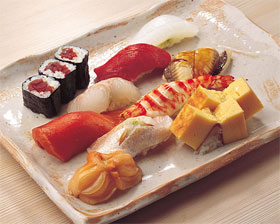 © Ito Chiharu 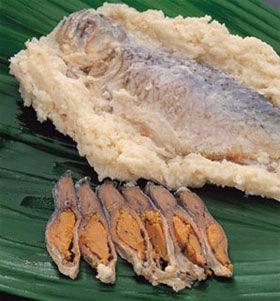 Funa-zushi © Hibino Terutoshi, Kawada Masahiro and Kono Toshihiko 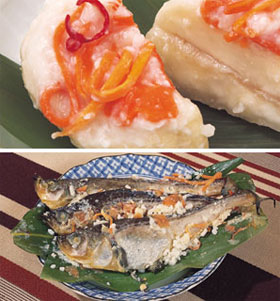 Kabura-zushi, Hatahata-zushi © Hibino Terutoshi, Kawada Masahiro and Kono Toshihiko 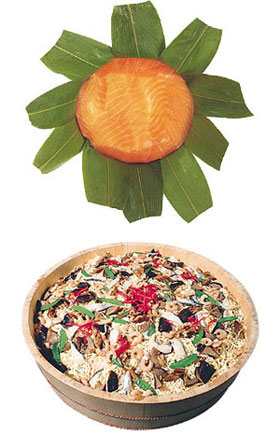 Hako-zushi, Chirashi-zushi © Masunosushi Honpo Minamoto, Hibino Terutoshi 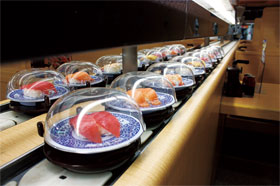 © Kura Sushi, Inc. |
Resources
|
Hibino, Terutoshi. 2008. “Sushi: Ancient Traditions Still Strong Today”. NIPPONIA. https://web-japan.org/nipponia/nipponia47/en/feature/feature11.html. Sanada, Kuniko. 2008. “Sushi Archipelago”. NIPPONIA. https://web-japan.org/nipponia/nipponia47/en/feature/feature13.html. Miyashita, Yuji. 2008. “How Come Almost Everyone Likes Sushi?”. NIPPONIA. https://web-japan.org/nipponia/nipponia47/en/feature/feature01.html. “Culinary Entertainment With The Ever-Evolving Kaiten-zushi”. 2019. Web Japan. https://web-japan.org/trends/11_food/jfd201910_kaiten.html. |
|
Japan Creative Centre 4 Nassim Road, Singapore 258372 +65 6737 0434 / jcc@sn.mofa.go.jp https://www.sg.emb-japan.go.jp/JCC/ Nearest parking at Orchard Hotel & Delphi Orchard |
 |